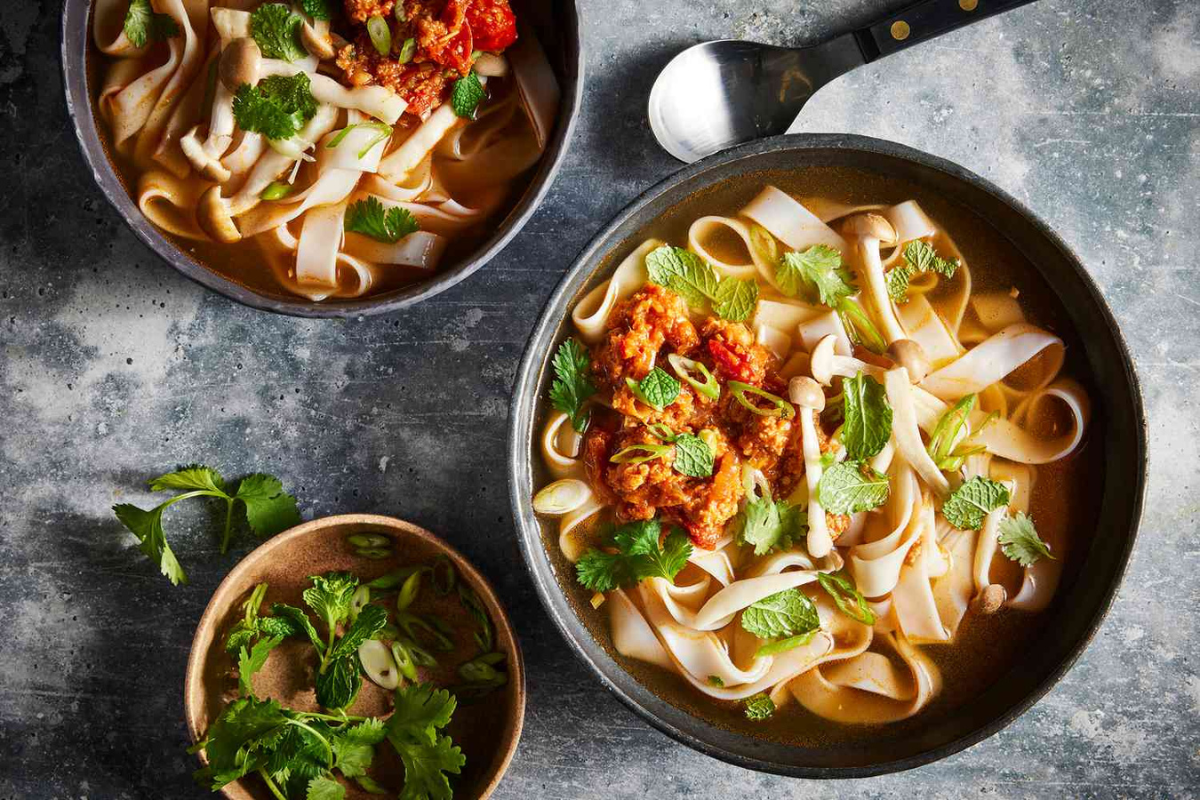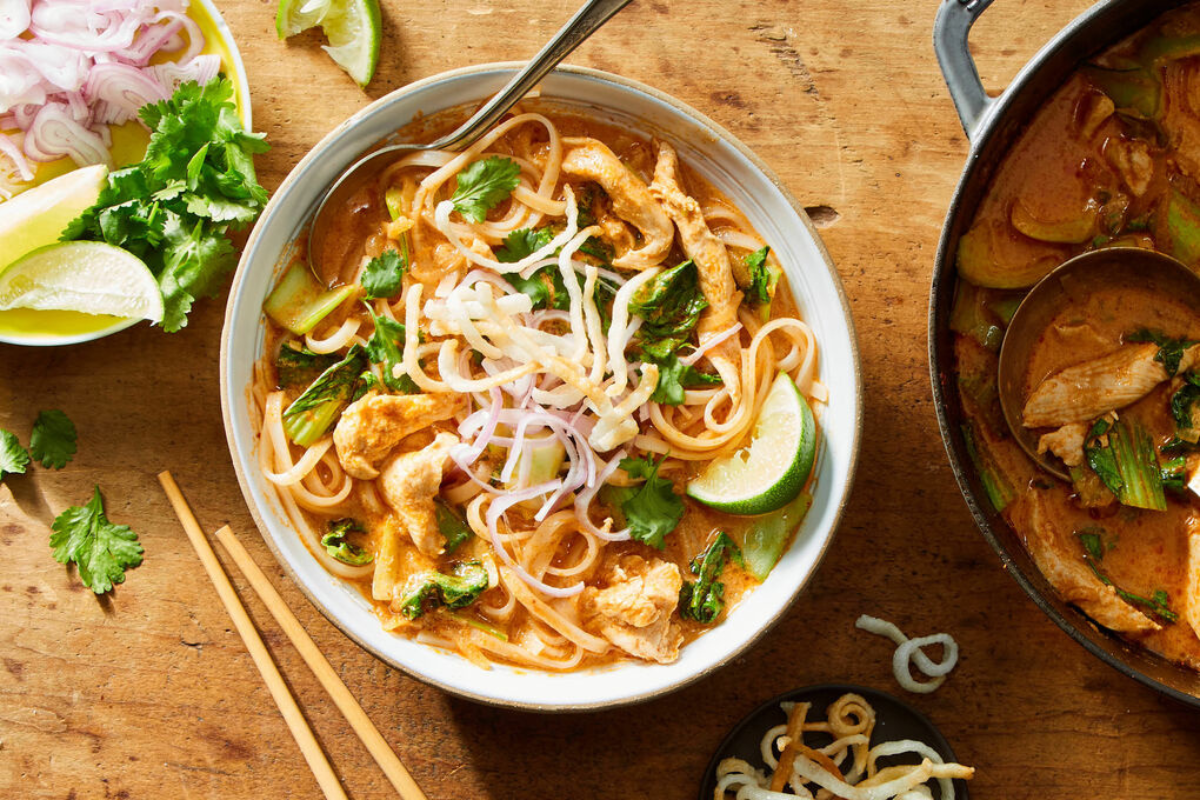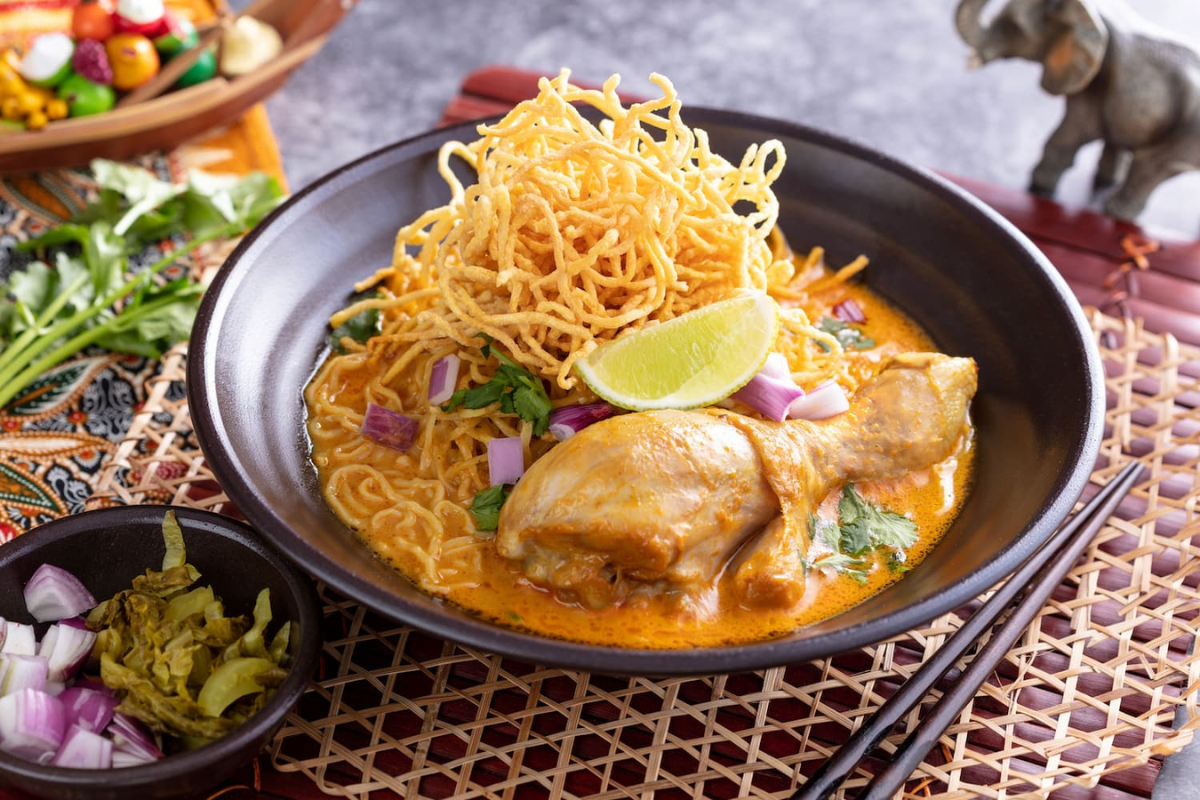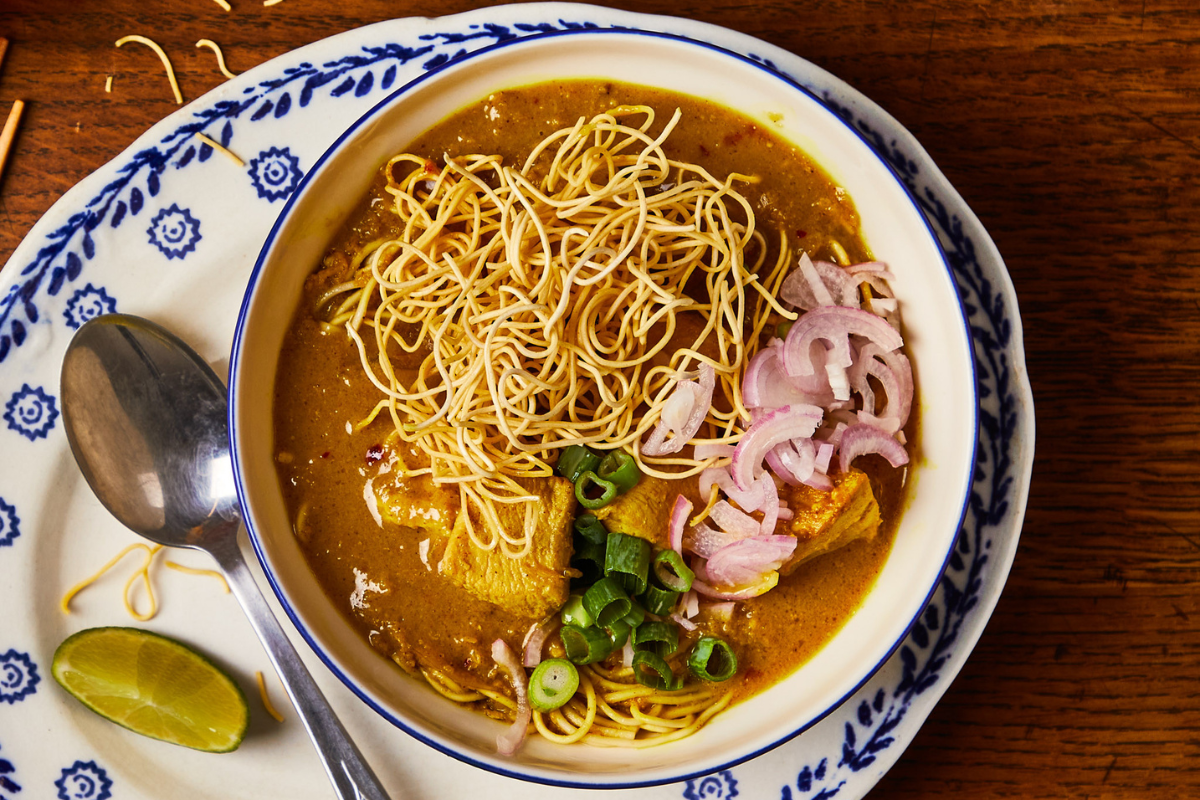With its vibrant tapestry of flavors and textures, Khao Soi stands as a crown jewel of Northern Thai cuisine. This iconic coconut curry noodle soup transcends mere satiation, offering a captivating story woven from history, cultural influences, and a unique blend of spices. In this comprehensive exploration, we’ll delve into the essence of Khao Soi, uncovering its origins, flavor profile, variations, and cultural significance, aiming to inspire a deeper appreciation for this culinary masterpiece.

Photo: Food & Wine
The exact origins of Khao Soi remain shrouded in the mists of time, with various narratives vying for recognition. Some believe it emerged from Shan traders migrating from Myanmar, bringing with them their noodle soup tradition “ohn no khao swè.” Others point to Chinese influences, highlighting similarities to “dan dan noodles.” Regardless of its precise birthplace, Khao Soi blossomed in the fertile culinary landscape of Northern Thailand, its flavors harmoniously intertwining with regional traditions.
The soul of Khao Soi lies in its captivating curry broth. A complex dance of spices unfolds on the palate, with turmeric imparting an earthy warmth, chilies offering a fiery kick, and aromatics like lemongrass and galangal adding fragrant depth. Coconut milk lends a creamy richness, balancing the spice with its subtle sweetness. This flavorful base cradles soft, chewy egg noodles, creating a textural counterpoint to the crispy fried egg noodles often perched atop the dish.
Savoring Khao Soi transcends mere nourishment, evolving into a cultural experience. Each bowl arrives adorned with an orchestra of accompaniments, each playing a crucial role. Pickled mustard greens add a sharp tang, balancing the richness. Shallots contribute a pungent bite, while lime wedges offer a burst of citrusy freshness. Crispy wonton skins lend textural contrast, and the fiery crunch of fresh chilies caters to adventurous palates. This interplay of flavors and textures invites diners to actively engage with the dish, crafting their own personal symphony of taste.
A culinary ambassador: Khao Soi on the global stage

Photo: Marley Spoon
In recent years, Khao Soi has transcended Thailand’s borders, captivating international palates. Its unique combination of vibrant flavors, textural contrasts, and inherent customization has resonated with food enthusiasts worldwide. This growing popularity reflects the versatility of the dish, adaptable to various taste preferences while retaining its core identity. Whether served in Michelin-starred restaurants or humble street stalls, Khao Soi continues its journey as a culinary ambassador, sharing a taste of Northern Thai culture with the world.
Khao Soi goes beyond a mere culinary delight; it embodies the cultural tapestry of Northern Thailand. Its emergence reflects the historical influences that shaped the region, showcasing the harmonious blending of Shan, Chinese, and Thai culinary traditions. The communal aspect of enjoying Khao Soi, shared amongst friends and family, reinforces the importance of social connection in Thai culture. Moreover, the dish serves as a source of livelihood for numerous vendors, highlighting its role in the local economy.
Khao Soi beckons with its enticing aroma, promising an adventure for the senses. Its story intertwines history, culture, and the art of crafting flavor. Whether enjoyed in the bustling streets of Chiang Mai or recreated in your own kitchen, this iconic dish has the power to transport you to the heart of Northern Thailand, leaving you with a lingering taste of its unique culinary magic. So, embark on your own Khao Soi odyssey, delve into its rich tapestry of flavors, and discover the captivating story it tells.
Variations across the region: A kaleidoscope of experiences

Photo: Asian Inspirations
While the core elements remain constant, Khao Soi exhibits delightful variations across Northern Thailand. Chiang Mai, the unofficial Khao Soi capital, boasts a signature yellow curry paste featuring turmeric and chilies. Further north, Mae Hong Son offers a red curry version with a touch of sweetness from palm sugar. For a vegetarian twist, head to Lamphun, where Khao Soi Gai with chicken is replaced with protein-rich chickpeas. These regional variations reflect the dynamism of Thai cuisine, where local ingredients and preferences shape beloved dishes.
Chiang Mai: The undisputed Khao Soi capital, Chiang Mai boasts the classic yellow curry paste. Turmeric dominates the stage, painting the broth a vibrant orange, while chilies bring a subtle heat. Boiled egg noodles bathe in the creamy embrace, often joined by tender chicken or beef. Crispy fried egg noodles perch atop the bowl, adding a textural counterpoint. Don’t miss the iconic Chiang Mai Khao Soi with its thicker consistency and bolder flavors.
Mae Hong Son: Nestled amidst breathtaking mountains, Mae Hong Son offers a vibrant red curry version. Palm sugar whispers sweetness into the mix, creating a delightful contrast to the spice. Thicker rice noodles hold their ground against the robust broth, often paired with stewed pork or beef for a hearty option. Be sure to sample the local specialty, Khao Soi Nam Ngiew, featuring a rich broth enriched with pork blood for a unique depth of flavor.

Photo: Gousto
Lamphun: For a vegetarian twist, head to Lamphun, where Khao Soi Gai with chicken undergoes a delightful transformation. Protein-rich chickpeas take center stage, simmered in the signature yellow curry broth. The result is a hearty and flavorful alternative, showcasing the versatility of this beloved dish. Look out for Khao Soi Sai Oua, a unique Lamphun variation featuring fermented sausage for a pungent and savory punch.
Nan: As you venture further north, Nan welcomes you with a Khao Soi boasting influences from neighboring Myanmar. The broth takes on a slightly darker hue, often incorporating fermented soybean paste for a complex umami flavor. Rice noodles reign supreme here, paired with braised pork or fish for a satisfying meal. Seek out Khao Soi Nam Khua, a Nan specialty featuring stir-fried pork belly that lends a smoky richness to the dish.
Chiang Rai: In the heart of the Golden Triangle, Chiang Rai presents a Khao Soi experience influenced by Shan communities from Myanmar. The curry tends to be milder, focusing on the aromatic depth of turmeric, lemongrass, and galangal. Flat rice noodles, called “khanom jeen,” soak up the flavorful broth, often paired with chicken or fish for a lighter option. Sample Khao Soi See Fai, a unique Chiang Rai creation featuring a broth simmered with charcoal or firewood for an earthy smokiness.
Beyond the unifying elements of its broth and noodles, Khao Soi shines in its regional diversity. Each province in Northern Thailand adds its own unique twist, reflecting local ingredients, preferences, and culinary influences. Buckle up for a flavor expedition across the Khao Soi map.

